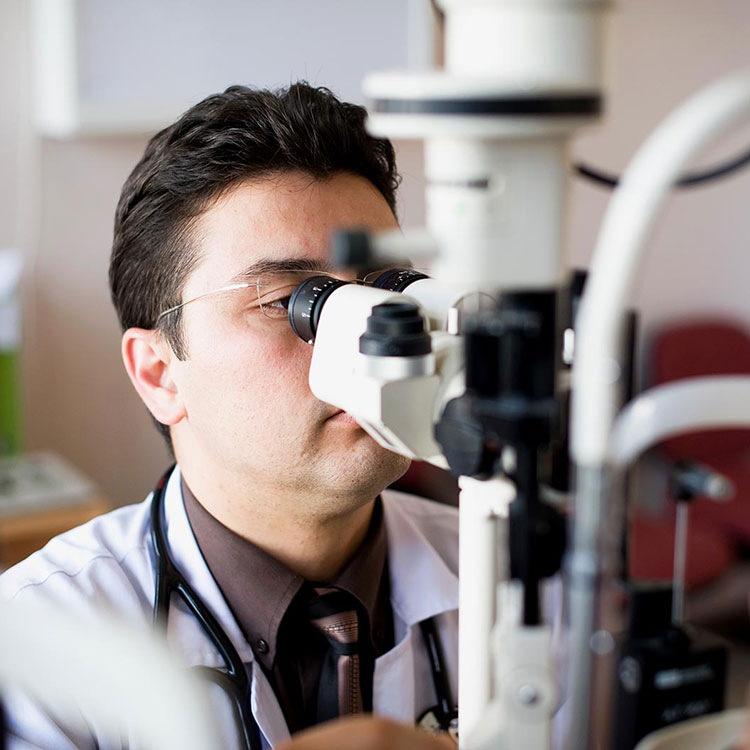Some people say the eyes are the window to the soul. Eye care professionals would say they are a window to your overall health. An eye doctor can tell a lot about the health of your body from looking in your eyes, and can even see signs of many serious health issues. Americans are more likely to see their eye care professional for an eye exam than their general healthcare provider for a physical, so eye doctors may be the first health professional to detect several serious conditions.
Early disease detection through an eye exam can lead to prevention or earlier treatment to help reduce medical costs and productivity loss down the road. Below are just three major health issues that can be detected by an eye exam.
Prediabetes
Before developing type 2 diabetes, people almost always have prediabetes. Prediabetes is when a person’s blood glucose levels are higher than normal, but not high enough to for a diabetes diagnosis.
According to the American Diabetes Association, there are 86 million people in the United States who have prediabetes. The good news is that people with prediabetes can take steps to prevent type 2 diabetes.
Early detection is key, and since blurred vision is one of the first signs of diabetes, your eye doctor may be the first health professional to see you while you’re still in the “pre-diabetic” state – and can take steps to keep the disease from progressing.
Without intervention, diabetes can have a serious impact on many areas of the body, and can result in staggering medical costs. Fortunately, early detection through an eye exam and taking steps to prevent progression of diabetes can impact your well-being, and also your wallet, through potential healthcare savings.
Undiagnosed diabetes
Of the 29.1 million people in the U.S. with diabetes, 27.8 percent are undiagnosed, according to the CDC.
Diabetes is a serious disease that occurs when your body cannot produce enough insulin – resulting in high levels of glucose in the blood.
Blurry vision can be one of the first signs of diabetes, so eye doctors are often the first health professionals to diagnose the disease. However, diabetes can be diagnosed in an eye exam even if no symptoms are noticeable. People who are diagnosed can more easily get their diabetes under control, and save money on medical expenses.
People with diabetes should see their eye doctor regularly to keep tabs on eye health issues that can be caused or worsened by the disease, including diabetic retinopathy and cataract. Having diabetes can also make you more susceptible to damage from UV rays and more sensitive to glare. This makes UV- and glare-blocking lenses, like Transitions lenses, a common recommendation.
Better managing diabetes can lower healthcare costs by a minimum of $804 per person per year…
Better managing diabetes can lower healthcare costs by a minimum of $804 per person per year, according to a study published in the Journal of Managed Care Pharmacy.30 Additionally, better managing the disease will help employees avoid extreme productivity issues that could lead to job loss, thereby avoiding the cost of unemployment associated with the disease, as reported in an American Diabetes Association study.
Undiagnosed high blood pressure
Approximately 1 in 5 people with high blood pressure doesn’t know they have it.
Without intervention, high blood pressure – also known as hypertension – can have a serious impact on many areas of the body and can lead to hefty medical costs.
For example, high blood pressure can contribute to the development of heart disease. Hypertension, with its complications of stroke and heart attack, accounts for Americans losing 52 million workdays each year, according to the National Hypertension Association.
Among its effects on the eye, hypertension can lead to bleeding, blurred vision, hypertensive retinopathy and even blindness.
Fortunately, eye doctors can see signs of hypertension in the eye by observing the thickening of blood vessels there and looking for other signs of damage.
Early detection through an eye exam and taking steps to prevent the worsening of high blood pressure can impact your well-being, and also your wallet, through potential healthcare savings.
For more information about vision conditions and to learn about their financial impact, it’s encouraged to visit Fit Fwd at davisvision.com/fitfwd. There, you’ll find a wealth of materials that can help encourage a spirit of wellness, including calculators and supporting whitepapers.
Source:
About the Sight On Savings Calculator. (2017, March). Retrieved from Fit Fwd by Davis Vision: http://www.davisvision.com/WhatsMyRisk/

